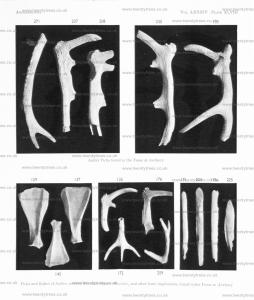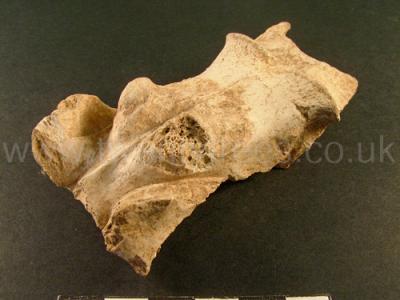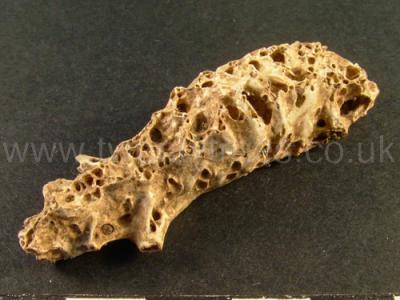Animal Artefacts
Animal Artefacts is in Prehistoric Artefacts.
Books, Prehistory, Prehistoric Artefacts, Animal Artefacts, Animal Bones
Windmill Hill Causewayed Enclosure [Map]. Historic England 1008446.
The monument includes a Causewayed Enclosure, a small mortuary enclosure, part of an early prehistoric field system and a group of eight Bronze Age round barrows forming the core of a wider round barrow cemetery, all situated on Windmill Hill, a prominent but low hill north-west of Avebury. Until recently, the Causewayed Enclosure and broadly contemporary mortuary enclosure were thought to be the earliest evidence for human occupation of the hilltop. Prior to this date, however, it would appear that the hill was under cultivation. On the eastern side of Windmill Hill are a series of slight earthworks which form the outlines of field boundaries and enclosures. Recent survey work has suggested that this field system runs beneath the enclosure and is therefore of earlier date. The causewayed enclosure has a small circular area surrounded by three roughly concentric rings comprising banks and ditches, centred just north and downslope of the summit of Windmill Hill. The ditches are interrupted at regular intervals by causeways, created as a result of the gang construction method used to form the ditches and banks. The outer limits of the enclosure form an oval ring aligned roughly south-west to north-east. The overall dimensions of the enclosure are 400m by 300m at the widest points. Numerous excavations of the causewayed enclosure, originally by Keiller, then by Smith in the 1960s, and more recently by Whittle, have contributed much to our understanding of the site. Finds have included Neolithic flint artefacts such as arrowheads, axe-heads, a sickle blade and scrapers. Ceremonial chalk cups, animal bones and skulls have also been found.
A type of Neolithic pottery found on sites across Wessex was first identified here and has taken the name of the site. The enclosure was in use from about 3000BC to around 2500BC. Broadly contemporary with the causewayed enclosure, and situated to the east and located immediately outside a causeway leading into the outer ring of earthworks, is a mortuary enclosure. This was used for the exposure of human corpses prior to their formal burial in mounds or chambered tombs such as nearby West Kennet [Map]. Although not visible at ground level, it survives as a rectangular enclosure 33.5m long by 22m wide defined by a buried ditch 0.3m wide.
South Street Long Barrow [Map]. Historic England 1008103.
The monument includes a Neolithic Long Barrow 70m south east of the Long Stones Cove aka Devil's Quoits [Map] standing stones and c.300m north east of the Long Stones long barrow, a contemporary funerary monument. The South Street long barrow, despite having been reduced by cultivation and partly excavated, survives as a slight earthwork visible at ground level. The barrow mound is aligned ESE-WNW and is known from excavation to measure 43m in length and 17m across. However, the mound has been spread by cultivation and now measures 64m in length and 43m across. Partial excavation has shown that the mound was constructed of chalk rubble tipped into a series of forty bays, created by the laying out of hurdle fences to mark out the site immediately prior to construction. This building method provided stability to the mound and guided the workforce in deciding where to dump the material quarried from two parallel flanking ditches. These ditches are located c.7m from the base of the mound on both sides and measure c.55m long and c.7m wide. The ditches have been gradually infilled by cultivation over the years but survive as buried features beneath the present ground surface. Radio-carbon dating of some of the finds from the later excavation date the construction of the mound to around 2750BC, making the monument over 4000 years old. Finds from the excavation included flint arrowheads, animal bones and fragments of pottery. Below the barrow mound evidence of early ploughing was discovered, taking the form of lines of cross-ploughing incised into the chalk.
Books, Prehistory, Prehistoric Artefacts, Animal Artefacts, Animal Skulls
Windmill Hill Causewayed Enclosure [Map]. Historic England 1008446.
The monument includes a Causewayed Enclosure, a small mortuary enclosure, part of an early prehistoric field system and a group of eight Bronze Age round barrows forming the core of a wider round barrow cemetery, all situated on Windmill Hill, a prominent but low hill north-west of Avebury. Until recently, the Causewayed Enclosure and broadly contemporary mortuary enclosure were thought to be the earliest evidence for human occupation of the hilltop. Prior to this date, however, it would appear that the hill was under cultivation. On the eastern side of Windmill Hill are a series of slight earthworks which form the outlines of field boundaries and enclosures. Recent survey work has suggested that this field system runs beneath the enclosure and is therefore of earlier date. The causewayed enclosure has a small circular area surrounded by three roughly concentric rings comprising banks and ditches, centred just north and downslope of the summit of Windmill Hill. The ditches are interrupted at regular intervals by causeways, created as a result of the gang construction method used to form the ditches and banks. The outer limits of the enclosure form an oval ring aligned roughly south-west to north-east. The overall dimensions of the enclosure are 400m by 300m at the widest points. Numerous excavations of the causewayed enclosure, originally by Keiller, then by Smith in the 1960s, and more recently by Whittle, have contributed much to our understanding of the site. Finds have included Neolithic flint artefacts such as arrowheads, axe-heads, a sickle blade and scrapers. Ceremonial chalk cups, animal bones and skulls have also been found.
A type of Neolithic pottery found on sites across Wessex was first identified here and has taken the name of the site. The enclosure was in use from about 3000BC to around 2500BC. Broadly contemporary with the causewayed enclosure, and situated to the east and located immediately outside a causeway leading into the outer ring of earthworks, is a mortuary enclosure. This was used for the exposure of human corpses prior to their formal burial in mounds or chambered tombs such as nearby West Kennet [Map]. Although not visible at ground level, it survives as a rectangular enclosure 33.5m long by 22m wide defined by a buried ditch 0.3m wide.
Books, Prehistory, Prehistoric Artefacts, Animal Artefacts, Cattle Species
Auroch
Auroch aka Bos primigenius. An extinct species of wild cattle believed to be the ancestor of modern domestic cattle.
Bos Longifrons
Bos Longifrons. "This is the smallest of all the ox tribe which lived in a wild state in our portion of the globe. To judge from the skeleton, it was 5 feet 4 inches long from the nape to the end of the rump bone, the head about 1 foot 4 inches, so that the whole length must have been 6 feet 8 inches. From the slender make of its bones, its body must rather have resembled a deer than our common tame ox; its legs at the extremities are certainly somewhat shorter and also thinner than those of a crown-deer (full-antler'd red deer)."
Wiltshire Archaeological Magazine 1913 V38 Pages 379-414. Tilshead. 5. "Tilshead Lodge Barrow," W. of Tilshead Lodge, N. of the Tilshead — Chitterne Koad. (This road is not shown on Hoare's Map.) Length 173ft. (Hoare); E. and W. Opened by Hoare and Cunnington; they found a secondary burial of a skeleton under the turf near the E. end, and noticed the usual stratum of black earth on the floor of the barrow, but failed to find the primary burial. It was re-opened by Thurnam, who found the primary burial of two skeletons as well as secondary interments, but no details of the discovery seem to have been published.
The following is the entry in the MS. Cat. in reference to this barrow: "No, 230. Ancient British. From Long Barrow near Tilshead Lodge, exhumed by Dr. Thurnam, Sept. 1st, 1865. From a skeleton in the contracted position at the base of the barrow, near the east end. This and the skeleton from which skull 231 was taken no doubt formed the primary interment. No. 231. Ancient British. From the same barrow as No. 230, and from a skeleton forming part of the primary interment, and separated only from that by a space of about one foot. Like it, its doubling up, or contraction, was excessive, the skeleton occupying no more than 1½ cubic feet. There was reason to suppose from the appearance of the left side of the skull, and the position of the long bones in regard to it, that this last had been cleft at the time of death. With neither skeleton was there any relic, but about a foot to the west of the last was a fine skull of Bos longifrons. At the base of the barrow near the west end was a second skull of the same species of Bos somewhat less perfect than the last, though with six or seven of the cervical vertebrae in situ. A foot or so above the first skull of Bos I. were several fine antlers of red deer, and a metatarsal bone and phalanges of Bos I. Note. I (Dr. Thurnam) retain the first skull of Bos l., the second has been presented to the Museum at Oxford, with the remains of Bos I. from other long barrows." No. 232. Anglo-Saxon. From a secondary interment about a foot below the turf near the centre of the same barrow; the skeleton stretched at length, with the head to the west. On the neck and upper part of the chest were the remains of a shield consisting of the umbo, handle, and four studs, all of iron. Close to the head were the decayed remains of a small situla, or bucket, of wood, bound with thin hoops of brass."
This barrow, though now down to grass, appears to have been under cultivation for some time, and to have been considerably lowered in consequence; the ditches, however, are still visible. O.M. 53 NW.; A.W. I. 91; Arch. xlii. 180, 182, 184, 196; Mem. Anthrop.Soc.nl 67; MS. Cat. 230-232.
Archaeologia Volume 84 1935 Section VI. Two antler picks, nos. 124 and 128, were found on or close to the bottom of the fosse, depth 165 ft. and 188ft. respectively (p. 151). In Cutting I a fragmentary shoulderblade bone was found near the bottom of the ditch. In Cutting II three well-defined specimens of shovels (scapulae) were found, two (nos. 129 and 137) shoulder-blades of ox (Bos longifrons) being found on the floor of the fosse at depths of 18.5 It. and 18.8 ft respectively; the other (no. 145) was a scapula probably ol a young ox, found at a depth of 14.3 ft. in the chalk rubble, having apparently slipped down from the vallum before it became turf-clad. The two shovels, nos. 129 and 137, measure 13¾ in. and 12½ in. in length. In nos. 129 and 145 the anterior spine has been cut away, or partly removed, and from this fact and the worn appearance of these three specimens, together with the great scarcity of other animal remains except the antler picks at such a great depth, we regard it as more than probable that these scapulae were used as shovels in the original excavation and clearing of the fosse.1 The three specimens are illustrated in pl. XLVIII.2
Note 1. In Archaeologia, LXII, 113, the late Horace W. Sandars said, ‘Some doubt has been expressed as to whether scapulae were employed for such purposes (shovelling chalk), but further and con¬ vincing proof of such usage has recently been afforded by the investigations carried out by Mr. H. St. George Gray at Avebury, where similar implements in association with deer-horn picks have been found at the bottom of the deep ditch that surrounded the monument.’
Similar bone shovels have been found at Cissbury (one is figured in Anchaeologia, XLV, 345). But perhaps the most interesting are the five specimens found in the Harrow Hill flint-mines, 1924-5, and described by Drs. Eliot Curwen and E. Cecil Curwen in Sussex Archaeol. Coll., LXVII, 103-38; they include a unique example with the neck of the bone hollowed out by a deep tapering groove for the insertion of a handle (see illustrations in their paper, p. III). Dr. E. C. Curwen has also written some notes on the use of these scapulae as shovels (op. cit., 139-45). Portions of three worked shoulder-blades were found at All Cannings Cross: see Mrs. Cunnington’s book on the subject, pl. 10, figs. 1, 2, and pl. 14, fig. 3. A specimen was found in a flint-mine at Stoke Down, near Chichester, and is now in the Brighton Museum (Proc. Preh. Soc. E. Anglia, IV, 89).
Two shoulder-blades of somewhat similar character were found in the Glastonbury Lake Village; see the work on the subject by Dr. A. Bulleid and Mr. H. St. George Gray, II, 415. They have been found in rather large numbers in the excavations being conducted at the Meare Lake Village 4 miles W. of Glastonbury; a small proportion of them is ornamented.
Note 2. No. 129 is preserved in the British Museum, no. 137 at Devizes, and no. 145 in the Pitt-Rivers Museum at Oxford.

Cattle
Cattle are large, domesticated, cloven-hooved herbivores.
Deer
Red Deer
Red Deer aka Cervus elephus. The red deer is one of the largest deer species. The red deer inhabits most of Europe, the Caucasus Mountains region, Anatolia, Iran, and parts of western Asia. It also inhabits the Atlas Mountains of Northern Africa; being the only living species of deer to inhabit Africa.
Wiltshire Archaeological Magazine 1913 V38 Pages 379-414. Fittleton.1 5. [Weather Hill Long Barrow [Map]] On Weather Hill, S. of Everley and W of the old Marlborough — Salisbury Road. Length about 150ft. N.E. and S.W. Opened by Thurnam, who does not seem to have published any account of the excavations beyond that in the summary list in Arch. xlii. The following entry, however, appears in the MS. Cat.: — "255. Ancient British. Part of a very dolichocephalic calvarium obtained from the north broad end of a long barrow on Fittleton Down, near Chidbury Camp, Oct. 6, 1866. The barrow had been previously disturbed. There were indications of one skull only, and that apparently a female. Remains of bos longifrons and horns of Cervus elaphus? scattered."
The barrow stands on an uncultivated down in good condition with well defined ditches. It shows where it has been dug into, no doubt by Thurnam. This barrow is referred to by Thurnam as "Fittleton."2 O.M. 48 N W.; A. W. I. Map of Everley Station; Arch. xlii. 180; MS. Cat. No. 255.
For Long Barrows in Fittleton parish now destroyed see end of this list.
Note 1. This is not the barrow opened by Wm. Cunnington in 1851, referred to in W.A.M. xxviii. 172. For that see below, List of barrows now destroyed, under Fittleton.
Note 2. Hoare shows two Long Barrows lying near each other on Weather Hill but there is no trace of the second barrow to be found now, and only one is shown on the O.M. As the down does not appear to have been under recent cultivation this was possibly an error of Hoare's.
Books, Prehistory, Prehistoric Artefacts, Animal Artefacts, Ox Skull
Amesbury 42 Long Barrow [Map] is a Long Barrow at the end of the Stonehenge Greater Cursus. It was noted by William Stukeley (age 35) in 1723 and Richard Colt Hoare 2nd Baronet (age 51) in 1810. It was excavated by John Thurnam in 1810 who recovered an Ox Skull and discovered secondary inhumations. The barrow is now levelled.
Wiltshire Museum. DZSWS:STHEAD.264f. Base of ox (bos longitrons) skull found with a primary cremation (in an upright collared urn) in bowl barrow Winterbourne Stoke G28 [Map], excavated by H. Cunnington.

Books, Prehistory, Prehistoric Artefacts, Animal Artefacts, Swan Sacrum
Wiltshire Museum. DZSWS:STHEAD.264g. 1 sacrum of a swan found with a primary cremation (woman ?) in an upright collared urn in bowl barrow Winterbourne Stoke G28 [Map], excavated by H. Cunnington.
